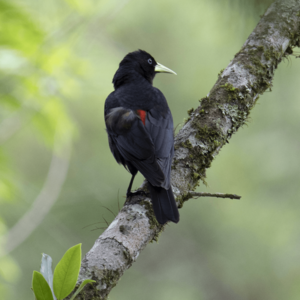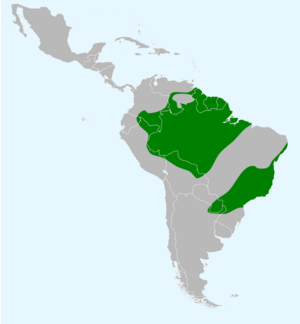Red-rumped cacique facts for kids
Quick facts for kids Red-rumped cacique |
|
|---|---|
 |
|
| Conservation status | |
| Scientific classification | |
| Genus: |
Cacicus
|
| Species: |
haemorrhous
|
 |
|
| Synonyms | |
|
Oriolus haemorrhous Linnaeus, 1766 |
|
The red-rumped cacique (Cacicus haemorrhous) is a cool bird that belongs to the Icteridae family. These birds are known for their bright colors and interesting calls. You can find them mostly in the Amazon Basin and the Guyanas in northern South America. They also live along the coast where the Amazon River meets the Atlantic Ocean.
There's another big group of these birds far away in southeastern and coastal Brazil, including parts of Paraguay and northeastern Argentina. You can also spot them in countries like Bolivia, Colombia, Ecuador, French Guiana, Guyana, Peru, Suriname, and Venezuela.
Where Do They Live?
Red-rumped caciques love to live in certain places. Their favorite homes are:
- Warm, wet lowland forests in tropical areas.
- Tropical swamps, which are wet, marshy lands.
- Areas that used to be forests but have changed a lot.
These birds need these specific habitats to find food and build their nests.
How It Got Its Name
Who Named This Bird?
The famous Swedish scientist Carl Linnaeus gave the red-rumped cacique its scientific name in 1766. He first called it Oriolus haemorrhous. Linnaeus is well-known for creating the system we use today to name all living things.
What Does "Haemorrhous" Mean?
The second part of its scientific name, haemorrhous, comes from two old Ancient Greek words. "Haima" means "blood," and "orrhos" means "rump." So, the name basically means "blood-rumped," which describes the bird's red patch!
Today, the red-rumped cacique is the main bird in a group called Cacicus. This group name was first used by a French scientist named Bernard Germain de Lacépède in 1799.


